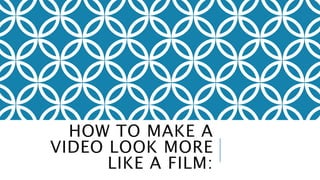
How to make a video look more like a film.
- 1. HOW TO MAKE A VIDEO LOOK MORE LIKE A FILM:
- 2. DEPTH OF FIELD: The depth of field is a reference to the distance between the closest and furthest objects in the frame that are in focus. A narrow depth of field means that anything slightly behind or away from the object in focus will be out of focus. This means that the main subject the audience will be viewing would be the thing that is in focus and nothing else. Whereas a deep depth of focus means everything within the scene is in focus. This is an important key when creating a film as it helps the audience focus on the most important things within the frame as well as to understand the effect of what is happening within the scene.
- 3. FRAME RATE: Since the days of early film most films were shot at projected at 24 frames per second, therefore the audience is accustomed to this frame rate. Therefore it is important to ensure that the camera is set to this rate unless the effect of slow motion is needed then a higher frame rate is needed. E.g. I an individual films at 60 frames per second then later slows it down to 24 frames per second then the footage would play at 40% of the speed. If a film is shot at 24 frames per second then it will create ‘motion blur’.
- 4. SHUTTER SPEED: It is important to follow the 180 rule when setting the shutter speed. This means that the shutter speed is set to double the frame rate. It is important to have the correct shutter speed as if it is too slow, the footage will appear as if it is strobing and ghosting as images appear. However if the frame rate is too high the image will look like it has been speeded up. However there are times when a slower or faster shutter speed is needed in order to create an effect.
- 5. CAMERA MOVEMENT: Camera movement can include putting the camera on the tripod and having no movement at all, the going to a handheld or going to a crane or dolly shot. It is important to use the right camera movement for each shot, as if you use the wrong camera movement the film could look ‘cheap’ and make the audience feel less connected with the product as it will lose the elements needed to engage the audience.
- 6. MANAGING HIGHLIGHTS: Most digital cameras lose a lot of the picture as they often blowout the bright areas within the frame. Sometimes this can be pleasant to look at if the highlights are in the correct place, and are intentional. However on video blown out highlights can look really bad and ruin the frame. This is because the light doesn’t roll of the same on the film. This can be dealt with by making sure that the frame isn’t overexposed. By making sure that the film isn’t overexposed the frame is still able to have some detail in it.
- 7. FRAMING: Framing is vital when making a film, this is because a lot of the detail of a scene can be lost with bad framing. E.g. if you have a well lit shot and a shallow depth of frame, but the subjected within the frame isn’t position right, then the whole shot would lose it effect.
- 8. LIGHTING: Lighting is a very important factor in creating a film as a poorly lit frame can make footage look ‘cheap’ and ‘poor quality’. No amount of colour would be able to make up for a poorly lit shot. Therefore it is important to get the right light exposure on the film as well as to make sure that the lighting fits the mood and tone of the film.
- 9. COLOUR CORRECTION: This is an important part of post production, mainly when colour grading. It is important to have an idea on how you want your film to look before amending the settings of it. It is also important not to overdo the colouring of the film as it can ruin the look of the product. It is important to make sure that the colours of the film look as natural as possible, unless you are filming a horror or and action genre, as they have specific colours incorporated to the product to make them appear ‘unnatural’. However it is also good to change the warmth or cool down parts of the footage so that the frames can match the mood of the scenes/ film. It is also important to make sure that the contrast and brightness are set to suit the scene/ frame to help create the correct mood, and so that no detail is lost within the scene/ frame.